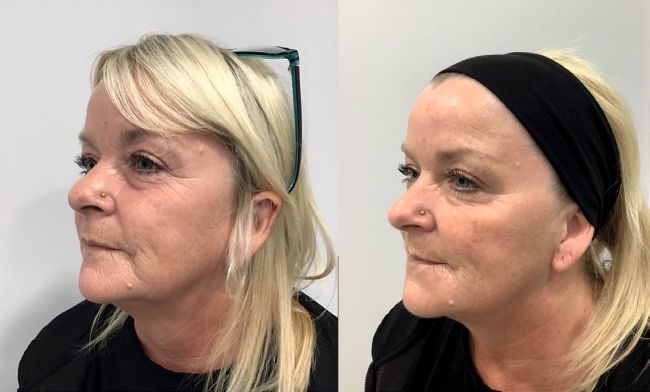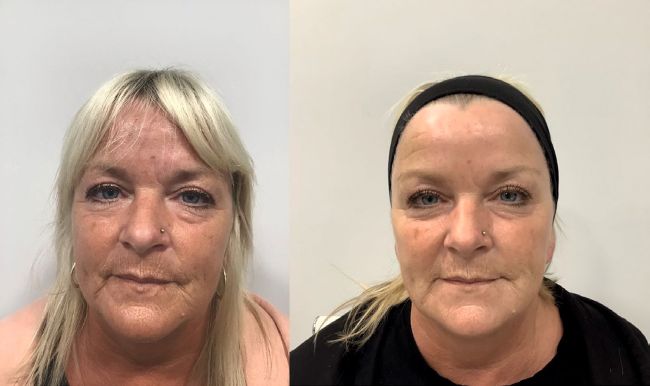FULL-FACE REJUVENATION
Fresh face
Aesthetic nurse prescriber and clinic owner Anna Kremerov talks us through a full-face injectable treatment for a patient with smoking damage
ANNA KREMEROV
Anna Kremerov is an independent nurse prescriber and founder and clinic director of Anna Medical Aesthetics in Swindon. She is a qualified practitioner in aesthetics, completing a Postgraduate Level 7 Injectables for Aesthetic Medicine. She is a member of the NMC, BACN and ACE Group. Her CQC-registered clinic is the first in Swindon to have been independently assessed against a robust set of standards in order to be certified as Save Face Accredited.
CONSULTATION
In this case, my patient was a 56-year-old female who had never had any treatments before. She presented to my clinic addressing multiple concerns such as general facial volume loss, general skin laxity, and poor skin quality. She expressed her concerns about her aged appearance and how it had dramatically affected her self-esteem and led to a lack of confidence. Specifically, she wasn’t happy with her under-eye shadows, dry and crepey facial skin, upper and lower lip wrinkles that cause lipstick bleed; and deep nasolabial smile lines. The patient felt that her face, mouth and lips had lost their previous structure, and she has been researching possible non-surgical options to help with her aged appearance. She wanted to achieve naturally healthy-looking results so no one would be able to notice she had any treatments done. While she was otherwise healthy, she had a history of heavy smoking, which is a well-known factor contributing to the skin’s wrinkles and premature ageing.

Left: before, right: after

Left: before, right: after
ASSESSMENT
On examination of the upper third of the patient’s face, a light central forehead concavity notably exacerbated the supraorbital ridges bilaterally. She had some volume loss and a moderate recession in the temples bilaterally. There were static lines present in the frown and forehead region, and there was a presence of redundant skin in the upper eyelid region bilaterally.
In the mid-third region, she had a sufficient lateral cheek projection. However, she was quite clearly hollow in the anterior and medial cheek, which exacerbated her under-eye appearance. She also had a mild eye bag appearance on the left due to herniation of the infraorbital fat compartment which was visually accentuated by the anterior cheek volume loss. On the examination of the lower third of the face, there were deep bilateral nasolabial folds and labial mental folds with notable bilateral jowl formation. Both lips were thin, with an increased distance from nose to the lip. Dominant chin was in line with the oral commissures.
The patient’s aged and tired look was enhanced by very elastotic skin and multiple superficial rhytids in the infraorbital and perioral region. Following the assessment, I concluded that isolated treatment might not be sufficient to achieve a pleasant aesthetic result.
TREATMENT OPTIONS
Different approaches, along with their advantages and disadvantages, were discussed in detail with the patient. While the patient knew very little about collagen depletion, she was keen to learn more about how a collagen-stimulating filler could help.
My strategy in treating this patient was to replace the facial volume, create adequate tissue support and improve dermal thickness and elasticity using a multi-factorial holistic approach combining injectable fillers and neuromodulators to achieve the long-lasting facial rejuvenation and natural-looking results.
My product of choice was Ellansé M since it works not only by volumising and correcting superficial rhytids but also by stimulating the body’s own collagen for a long-lasting, natural resul1,2 Ellansé is a collagen bio-stimulator composed of a totally bio-resorbable polycaprolactone (PCL) microspheres in a carboxymethylcellulose carrier gel. It offers immediately visible results, and it’s complete bioresorbability make this product suitable for patients seeking longlasting and stable results.
Additional consideration was given to smoking as a factor affecting skin ageing. I took the time to explain that smoking is strongly associated with skin elastosis, and it causes skin damage. It has been proven that smokers have fewer collagen and elastin fibres in the dermis, which in turn causes skin laxity. Smoking is also proven to cause constriction of the vasculature that may contribute to wrinkling.3
TREATMENT
Ideally, I planned to volumise the forehead and temporal region with dermal filler before treating the upper face region with botulinum toxin, but the patient wasn’t keen on treating the upper third of her face with dermal fillers at this stage. It has been agreed to start with upper face anti-wrinkle softening and structural full face rejuvenation using collagen stimulator Ellansé, and continue improving the skin texture in the perioral region using HA-based dermal filler.
The upper face was treated with Botox in frontalis, glabella and lateral orbicularis oculi region. The orbital rim was palpated and marked. The infraorbital foramen was identified and marked before injection, as this is a no-go area to avoid severe nerve and artery compression and embolism. On examination, there was a noticeable volume deficit in the anterior part of her cheek, so I decided to target this area to volumise and improve the patient’s infraorbital hollows indirectly. We agreed to treat the anterior part of her cheek and check what degree of improvement we could get in the infraorbital region with an indirect approach.
To facilitate a more comfortable procedure, I mixed 0.2ml of lidocaine 2% with each 1ml syringe of the product. It can be safely performed without altering the physical properties of the product.4 In the malar area, a combination of retrograde injections and small boluses were performed in the deep supraperiosteal plane, with 0.05-0.1ml per line/bolus using a 25G cannula. In this case, I used 0.5ml on each side. From the same cannula entry point, treatment was extended to the zygomatic malar region on the periosteal plane to provide a soft contour to the lateral cheek area, with 0.5ml administered on each side.

Left: before, right: after
“The patient stopped smoking to avoid further damage to her skin, and most importantly, she had her confidence back”
The submalar region was treated from the same entry point in the subcutaneous plane using a retrograde linear threading and fanning technique, with 0.05-0.1ml per thread. A total of 0.4ml was used on each side. More superficial placement of the product in the subdermal plane with the same size cannula was used to achieve biostimulation, to increase collagen production within the dermis and address subdermal volume loss.5 This technique was utilised over the mid-face region, with 0.6ml used on each side.
Correction of the nasolabial folds was performed using a 25G cannula on the periosteal plane using a small bolus of 0.1ml in the piriform fossae on each side and on the subcutaneous plane using retrograde fanning technique medial to the nasolabial folds, with 0.4ml on each side. Marionette lines and oral commissures were treated using a fanning and cross-hatching technique on the subcutaneous plane using 0.5ml on each side. The mental crease was treated using linear threading technique and retrograde injection on the subcutaneous plane using 0.4ml in total. The prejowl sulcus was initially approached directly using a 27G needle on the supraperisosteal plane 0.1ml bolus on each side. Following a direct approach, the prejowl sulcus and jawline were approached using a 25G cannula with an insertion point from the tuberculum mentale, parallel to the jawline. Ellansé was been placed deep on the supraperiosteal plane using a fanning technique, with 0.8ml on each side. In this case, I used 8ml of Ellansé M in total to achieve desirable volume replacement.
My preferred technique is using a cannula, which allows me to achieve a whole mid-face revolumisation with a minimal entry point. Using a cannula is a safer and more comfortable technique for the patient, which can also decrease the risk of potential side effects such as bruising, vascular compromise, bleeding and ecchymosi6,7 With any technique, I always use my non-injecting hand to palpate the skin and avoid overcorrection. It is also essential to slowly inject the product with small boluses and watch the tissue as you inject to see how much filling has been created.
RESULTS
At the two-week review, the patient was pleased with the results. She felt it was a life-changing treatment for her. Following her initial consultation, she stopped smoking to avoid further damage to her skin, and most importantly, she had her confidence back. Thanks to the unique product properties, further collagen bio-stimulation will help the patient improve facial laxity by stimulating the body’s own collagen for a long-lasting, natural result.

REFERENCES
1. Kim J. S. (2019). Changes in Dermal Thickness in Biopsy Study of Histologic Findings After a Single Injection of Polycaprolactone-Based Filler into the Dermis. Aesthetic surgery journal, 39(12)
2. de Melo, F., Nicolau, P., Piovano, L., Lin, S. L., Baptista-Fernandes, T., King, M. I., Camporese, A., Hong, K., Khattar, M. M., & Christen, M. O. (2017).
Recommendations for volume augmentation and rejuvenation of the face and hands with the new generation polycaprolactone-based collagen stimulator (Ellansé®). Clinical, cosmetic and investigational dermatology, 10, 431–440.
3. Leow, Y. H., & Maibach, H. I. (1998). Cigarette smoking, cutaneous vasculature, and tissue oxygen. Clinics in dermatology, 16(5), 579–584
4. de Melo, F., & Marijnissen-Hofsté, J. (2012). Investigation of physical properties of a polycaprolactone dermal filler when mixed with lidocaine and lidocaine/ epinephrine. Dermatology and therapy, 2(1), 13
5. Kim J. S. (2019). Changes in Dermal Thickness in Biopsy Study of Histologic Findings After a Single Injection of Polycaprolactone-Based Filler into the Dermis. Aesthetic surgery journal, 39(12)
6. van Loghem, J., Humzah, D., & Kerscher, M. (2017). Cannula Versus Sharp Needle for Placement of Soft Tissue Fillers: An Observational Cadaver Study. Aesthetic surgery journal, 38(1), 73–88.
7. Fulton, J., Caperton, C., Weinkle, S., & Dewandre, L. (2012). Filler injections with the blunt-tip microcannula. Journal of drugs in dermatology : JDD, 11(9), 1098–1103
8. Bass L. S. (2015). Injectable Filler Techniques for Facial Rejuvenation, Volumization, and Augmentation. Facial plastic surgery clinics of North America, 23(4), 479–488.